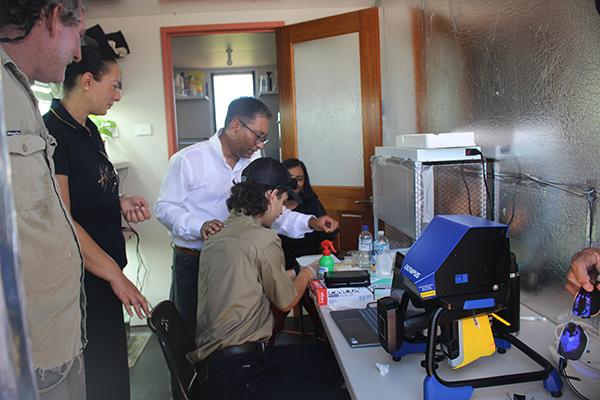Three years ago, Brian Earl got lots of time to think – and he put it to good use.
While every other conference in NCAA Division I resumed play following the pandemic-shortened 2019-20 season, the Ivy League canceled all sports competition for ’20-21. That gave , now in his eighth year as Cornell’s Robert E. Gallagher ’44 Head Coach of Men’s Basketball, a chance to take a 30,000-foot view of his Big Red, which hadn’t had a winning season in more than a decade.
“The pandemic was obviously rough on a lot of people, but it was a bit of a sabbatical for us in the Ivy League,” said Earl, a record-setting and championship-winning guard at Princeton University in the late 1990s under legendary coaches Pete Carril and Bill Carmody. “And so as a coach, you had a lot of time to learn a little bit about different ways of doing things.”
Earl had brought to Cornell a version of the methodical “Princeton offense,” which features screens and backdoor cuts to the basket. But after months in deep thought, watching documentaries of the high-flying Loyola Marymount men’s teams of the ’80s and ’90s, and studying offensive philosophies in other sports, Earl made a decision: At Cornell, we’re going to run, run, run.
Head Coach Brian Earl instructs his team during a timeout in the Big Red’s Ivy League game on March 1 at the University of Pennsylvania. Cornell defeated the Quakers, 87-81, at the Palestra.
That radical shift in style has helped fuel a Big Red resurgence. Cornell has posted its third straight winning season and is the No. 3 seed heading into this weekend’s Ivy League Tournament, at Columbia University’s Levien Gymnasium.
The Big Red (22-6 overall, 11-3 Ivy League) will face second seed Yale (20-9, 11-3) in the second of two semifinals, March 16 at 2 p.m.; the game will be shown on ESPN News. The first game, at 11 a.m. (ESPNU), pits regular-season champion Princeton (24-3, 12-2) against No. 4 seed Brown (8-6, 12-17).
The winners will meet for the championship – and the automatic NCAA Tournament berth that goes with it – at noon March 17 (ESPN2). Pairings for the first round of “March Madness” will be announced later that day.
Cornell is aiming for its first league championship since 2009-10, when it won a school-record 29 games, including two in the NCAA Tournament, to become first Ivy League team in 31 years to reach the Sweet 16. , the current Big Red associate head coach, was a senior forward on that team.
Re-imagining the Red
When everything came to a halt in March of 2020, the Big Red had just completed its 10th straight losing season, including four with Earl in charge. Something had to change.
While there was no competition in 2020-21, the team could practice, albeit with safety protocols in place.
“We had masks on, we needed 6 feet of distance between players, so we would do 3-on-2 drills where no one would come close to each other,” said Earl, who spent nine seasons on the coaching staff at his alma mater prior to arriving at Cornell in 2016. “And we’d shoot a lot of 3’s, and run a lot.”
“We were restricted in what we could do in terms number of guys in a workout and contact during workouts and all that,” Jaques said. “But Coach (Earl) invented certain drills that kind of mimic how we would play, and you could kind of see what it could be.”
In addition to the high-scoring basketball of Loyola Marymount, Earl also took some ideas from soccer – the counterattacking of Jürgen Klopp’s Liverpool club, and the “total football” philosophy popularized years ago by the Dutch that emphasizes using the whole field on offense and condensing it on defense. It also features players switching roles on the fly – defenders moving up into the attack and forwards dropping back.
“It was just a lot of connecting the dots on a lot of different things,” Earl said, “and then just being able to roll the dice when it came time to do it.”
Cornell unveiled its new up-tempo style in the first game of the 2021-22 season, at Binghamton University. Cornell won, 76-69, but not without some anxious moments.
“The first five minutes, it was mayhem,” said Earl, whose team led at that point, 15-11. “I thought, ‘Wow, the other team’s exhausted. Our team’s exhausted. Can we do this?'”
Sean Hansen ’24, the team captain, recalls those early days of the transition.
“You play as fast as you can, as hard as you can, and you’re going to get tired,” said Hansen, an engineering major from Ramsey, New Jersey. “You’re going to get subbed out, and then you’ll get right back in. For us as sophomores, first year playing, we knew we’d get some playing time. And the best thing you can do is just really give it your all and use 100% of your energy.”
That Binghamton game started a rebirth of Cornell men’s basketball: The Red went 15-11 that year and 17-11 last season, qualifying for the “Ivy Madness” league tournament both seasons. Cornell fell in the semifinals both times, and hopes to take it a bit further this year.








